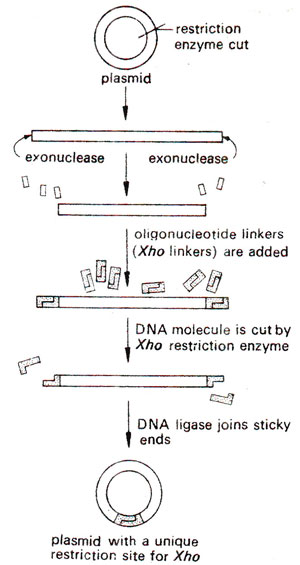Blunt end ligation by T4 DNA ligase
In this technique, a restriction enzyme is used to cut a duplex DNA at the same place in both the DNA strands. The broken ends are then used for joining with the two ends of another DNA molecule irrespective of the sequences present at the broken ends of the two DNA molecules. The T4 DNA ligase is used for this joining reaction. The disadvantage of this technique is that any two broken ends may join including those belonging to the same DNA molecule. This leads to the production of a variety of products and one will have to select the desired product from a mixture of products.
This blunt end ligation is used for developing a method in which the cloned DNA can be easily retrieved whenever required. This method makes use of short DNA duplexes ('linkers'), that contain EcoRIpalindrome or some equivalent palindrome, which being small in size, can be synthesized chemically. These 'linkers' can be linked to the blunt ends of vector DNA or of an insert by blunt end ligation (Fig. 39.15). This will allow the creation of an EcoRIsite in the linker region of the vector. Therefore, with this method it is now possible to insert a foreign DNA segment at a particular site in the linker region of the vector and then retrieve this foreign DNA segment whenever necessary.
This blunt end ligation is used for developing a method in which the cloned DNA can be easily retrieved whenever required. This method makes use of short DNA duplexes ('linkers'), that contain EcoRIpalindrome or some equivalent palindrome, which being small in size, can be synthesized chemically. These 'linkers' can be linked to the blunt ends of vector DNA or of an insert by blunt end ligation (Fig. 39.15). This will allow the creation of an EcoRIsite in the linker region of the vector. Therefore, with this method it is now possible to insert a foreign DNA segment at a particular site in the linker region of the vector and then retrieve this foreign DNA segment whenever necessary.





